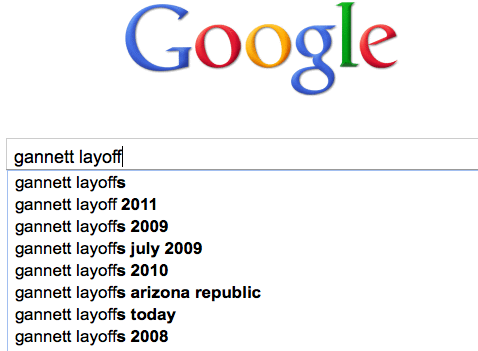Every Friday we round up media & tech industry news you may have missed while you were saying goodbye to the competition.
While we are seeing improved circulation results and audience growth, weakness in the real estate sector, slow job creation and now softer auto ad demand continue to challenge revenue growth in the division.
National advertising remains soft and with many of our local advertisers reducing their overall budgets, we need to take further steps to align our costs with the current revenue trends. Each of our local media organizations faces its own market conditions, challenges and opportunities. Therefore, it has been up to each local publisher to determine his or her unique course of action.
The red ink at Gannett also led the company to cease publication of alternative wannabes in Indianapolis, Lansing, and Rochester. Are more next?
Indeed, all its numbers look good. The dividend is up. Advertising increased by 15%. Print circulation grew by 4% to 1,473,939 (UK sales were up 11% to 210,204).
There has been digital success too. Since launching in November, its iPad and iPhone apps have been downloaded around 2m times. Online traffic has risen, with visits up 39% on the year before.
What’s weird about that? Only that it was just a couple months ago that Armstrong put all of his company’s content businesses into the hands of Arianna Huffington, one of the leading evangelists for the notion that news wants to be free and paywalls like the one the New York Times recently erected are doomed to fail. “The more people who put their content behind paywalls, the better it is for us,” as she recently put it to Ad Age
To be fair, Huffington’s not an absolutist on this point. She has long said that readers will pay for certain types of niche content, namely “financial information” and “weird porn.” And it sounds like the content Armstrong thinks AOL can start charging for is the stuff coming out of its new industry-specific verticals, AOL Energy, AOL Defense and the soon-to-launch AOL Government.
How does the Huffington Post differ from the New York Times? Fellow media oxpecker Steve Myers says many observers are missing the point:
I don’t think the key difference is aggregation, traffic or employees. It’s that one site values content in the service of conversation; the other values conversation in the service of content. Can you guess which site values what?
Meanwhile, HuffPo will be accelerating its expansion of local coverage to lure readers interested in campaign news ahead of the 2012 presidential election.
The Bangor Daily News announced this week that it completed its full transition to open source blogging software, WordPress. And get this: The workflow integrates seamlessly with InDesign, meaning the paper now has one content management system for both its web and print operations.
In this web-first workflow, reporters and editors compose their stories in Google Docs and once the story is ready to publish, can send it to WordPress with just one click.
The big idea: You come up with a deal, get your friends on board, and submit it to Loopt. They’ll then try to get their sales team to get the merchant to give you the deal. If it works, you get the deal.
I’m having a really hard time wrapping my head around how its ideologically consistent to villainize copycat sites while at the same time celebrating the launch of services that facilitate both the removal of content from an original source as well as the repackaging of that content in another form.
What’s the difference? Is it because the Byliner is well designed? Or because scraper sites are run by machines in foreign countries and the content on Byliner is being hand-picked by Real People Who Care About Reading? Or something else entirely? Or am I just incredibly daft and confusing two completely different things here?
The move to place “promoted tweets” in the main “stream” of tweets on the service is likely to be controversial with users who have seen only limited and unobtrusive marketing messages so far in Twitter’s five-year history.
Other commercial options under discussion include deals and offers similar in style to rival Groupon, which aggregates consumer demand for time-limited specific offers. It is also looking at introducing enhanced profile pages for brands and media management tools, which could allow advertisers to pre-schedule 140-character posts.
Meanwhile, Facebook has launched a new “comment ad” in an attempt to emulate word-of-mouth marketing.

